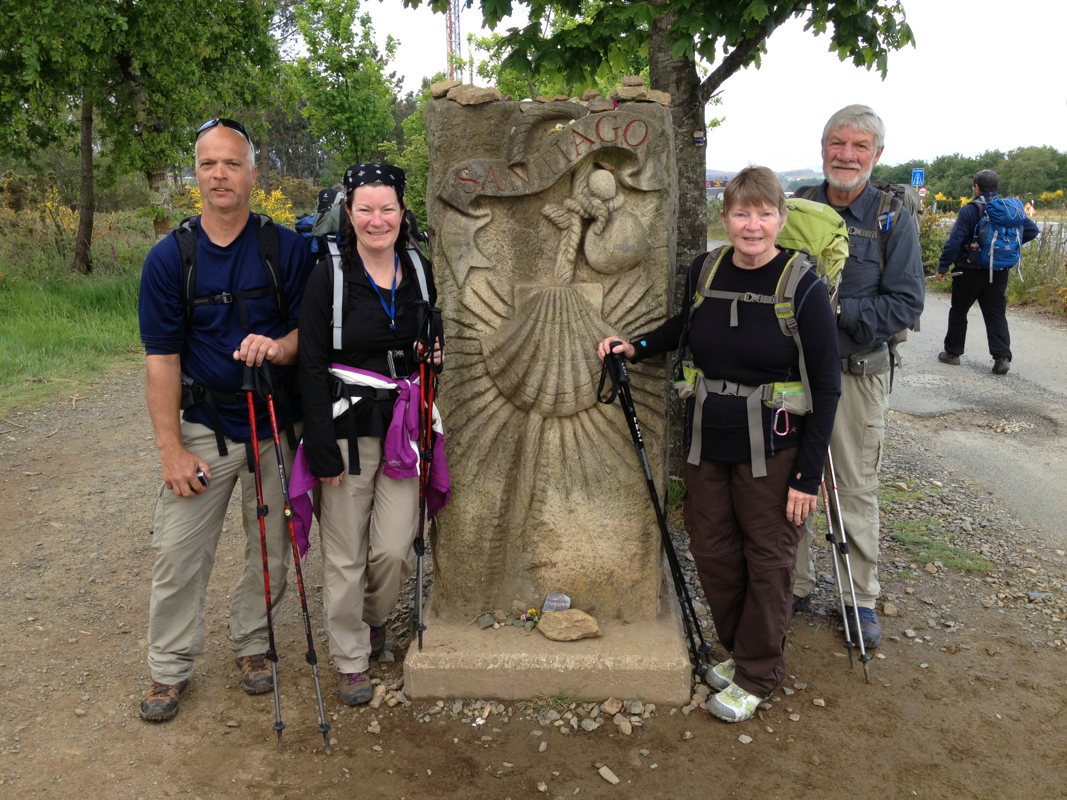|
Back a week now from our five weeks in Spain, we're finally getting a chance to sort through our photos. One of the recommended activities at our albergue in El Burgo Ranero had us as hospitaleros voluntarios leading our guests to the Laguna each night to watch the setting of the sun. We were blessed with few sunny evenings, but the few we enjoyed were recorded in many photographs. Each is unique, but the one above serves as a good stand-in for the others.
1 Comment
Somewhere recently I heard the sappy comment "People play golf to prove they aren't dead yet." I'm not about to (or able to) to offer any opinions on the merits of the game of golf or to draw any conclusions about why people take it up. Nevertheless something about the statement seems to have stuck with me, because it came back in the late morning of May 20, 2013. I was walking on the Camino, working my way down the incredibly beautiful but punishing trail from La Cruz de Ferro (1,505 meters) to Molinaseca (610 meters), a net loss of nearly 3,000 feet in about 11 miles. Spring's arrival in Spain was delayed this year, and that day the temperature topped off in the forties. A fierce headwind pierced windbreaker and the layers underneath, and numbed the fingers that grasped my walking poles. Rocks protruding from the path led to inevitable stubbing of bruised toes and occasional stumbles, and melting snow left puddles to be tiptoed around. Soles of both feet throbbed from repeated pounding on the earth, and legs felt the cumulative effects of many small shocks gotten on the long down-slope trek. Overloaded backpack was beginning to stress a neck muscle. Ears hurt, and nose wouldn't stop dripping. Lungs cried out for more oxygen to fuel the uncommon exertions of my seventy-year-old body.
Despite being surrounded by beauty, I couldn't stop pondering my many large and small discomforts. This surely was not for the faint of heart, I thought. Then the statement about proving you're not dead yet came to mind and helped me to understand. The proof was all around me! Aches, pains, struggles, doubts, and the beauty that couldn't be experienced any other way combined to remind me that I was indeed alive. The thought lifted the body and the spirit. At that moment I couldn't recall ever having felt so fully, wondrously, and gloriously alive. Monday we organized ourselves for the return to the real world. Then we tried to forget about the return and went to spend more time with the Camino. We visited the Museum of the Cathedral and had a last lunch, at Cervantes Square. Then off to the airport for Madrid, where we almost had to sleep in bunk beds because of some deceptive hotel advertising. But we negotiated our way into real double rooms and rejoiced over dinner, wine, and good stories until we had to quit the restaurant and turn in. Now we are all four back home. Tomorrow, Pam and James are back on the job and Russ and I are back to working on Second Wind on the Way of St James. It will be out within a few weeks. The last time Russ and I were in Santiago, in June 2011, it hailed and sleeted. We did not go to Finisterre because we decided we would not be able to see as far as the sea. This time, Pam and James brought good luck. It was a spectacular sunny day. We had gorgeous views all along the hike from town to the lighthouse and back. Because it was the feast of Corpus Christi, we were treated to booming, midday fireworks raining down on us as we hiked the 3 kilometers back from the end of the earth to the town to catch our magic carpet (nee bus) back to Santiago. And, we had time for a seafood lunch at a restaurant overlooking the harbor. Such a thing is a rarity and we were delighted, especially after all our weather experiences along the Camino, to share this one too. |
Archives
July 2022
AuthorsPeg and Russ Hall Categories
All
|
- Home
- Blog
- Second Wind
- Maps
- Why Walk It?
-
Practicalities
- Step 1. Planning Your Camino -- What kind, Where, When, How far, Alone, Getting there . . .
- Step 2. Getting Ready -- Training, Packing, Gear, Clothes, Electronics, Passports, TSA . . .
- Step 3. Being There -- Money, Lodgings, Food, Language . . .
- Step 4. Adapting -- Guidebooks, Websites, Trail conditions, Schedule, Water, Weather, Pain, Hazards, Phones . . .
- Step 5. Being a Pilgrim and a Tourist -- Types of pilgrimmage, Roman roads, Medieval life, Wonders . . .
- Step 6. Living the Lessons of the Camino -- Once or again, Connecting at home, Being hospitaleros . . .
- Who Are We?
- All Our Caminos



















 RSS Feed
RSS Feed